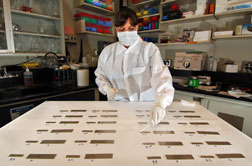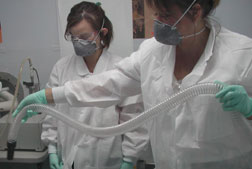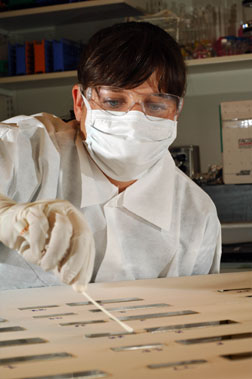NEWS RELEASES
FOR IMMEDIATE RELEASE
October 25, 2005
Sandia researchers determine that common anthrax sampling methods need improvement
More deadly spores may remain after decontamination than current sampling methods show
 Sandia researcher Mollye Wilson samples Bacillus
atrophaeus spores, bacteria similar to anthrax, but not
toxic, as part of a study to determine numbers of viable
organisms existing on a surface. (Photo by Randy
Montoya)
Sandia researcher Mollye Wilson samples Bacillus
atrophaeus spores, bacteria similar to anthrax, but not
toxic, as part of a study to determine numbers of viable
organisms existing on a surface. (Photo by Randy
Montoya)Download 300dpi JPEG image, “bio-detection.jpg,” 840K (Media are welcome to download/publish this image with related news stories.)
ALBUQUERQUE, N.M. — A research team from the National Nuclear Security Administration’s Sandia National Laboratories has discovered that common anthrax sampling methods need improvement. The research shows that more deadly spores remain after decontamination than previously believed.
The team, led by researcher Gary Brown, spent a year looking at sampling processes used to determine the number of viable organisms existing on surfaces following a biological attack with agents such as anthrax. The Department of Homeland Security (DHS) funded the study.
“We evaluated Centers for Disease Control and Prevention (CDC) recommendations for sampling methods and discovered that all current methods underestimated the number of spores, such as Bacillus anthracis, the organism causing anthrax, actually present on surfaces,” Brown says. “The sampling methods are much less effective than anyone realized.”
 Common vaccum sampling method no longer recommended.
Common vaccum sampling method no longer recommended.Download 300dpi JPEG image, “sampling-vacuum.jpg,” 488K (Media are welcome to download/publish this image with related news stories.)
Miscalculating the number of spores present following an attack could potentially be lethal.
The idea for the sampling study dates back to the fall of 2001 when letters containing anthrax bacteria were mailed to the offices of several news media and two U.S. senators, contaminating numerous postal facilities and killing five people. Critical questions became 1) how efficient are the various methods used to sample amounts of spores, 2) what minimum amounts of spores have to be present if anthrax is to be detected by these methods, and 3) how effective are the various methods for extracting material from samples for analysis.
Brown became involved in the study as part of a DHS-funded Domestic Demonstration and Application Program that was investigating the restoration of major transportation facilities in case of a bio attack.
 Mollye Wilson demonstrates sample collection techniques.
(Photo by Randy Montoya)
Mollye Wilson demonstrates sample collection techniques.
(Photo by Randy Montoya)Download 300dpi JPEG image, “swab.jpg,” 668K (Media are welcome to download/publish this image with related news stories.)
“If a bio attack occurs, we need to be aware of how many anthrax spores exist initially and how many remain after a cleanup,” Brown says. “No one knows how effective these cleanup methods really are, and you don’t want to leave material around after a building cleanup in concentrations capable of causing infection.”
The question of “how clean is clean” is important for many biological and chemical agents, not just for anthrax. The issue has received congressional attention and is an area in need of significantly greater study, he adds.
The study’s objective was to provide a robust scientific and statistical evaluation of current swab, wipe, and vacuum surface sample collection methods. The investigation was intended to empirically determine recovery efficiency and extraction efficiency, calculate collection efficiency, and determine each method’s limit of detection.
Reference surfaces of coupons were seeded by dry deposition with a mixture containing Bacillus atrophaeus spores (a bacteria similar to anthrax but not toxic) and silicon dioxide particles. Forty-eight coupons, each measuring 1.25 cm x 5 cm and made from stainless steel or painted wallboard, were used as the reference surfaces.
After seeding, the surfaces were sampled using traditional
collection methods — swabbing, wiping, and vacuuming.
The sampling team found that none of the sampling methods
was very efficient.
The swab system collected 40 percent of the spores, leaving 60 percent behind. The wipes collected 28 percent, leaving 72 percent on the coupons.
The biggest surprise was that the vacuum method collected only 20 percent of the spores, leaving 80 percent on the surface.
“Before this study, the vacuum method was the most highly recommended sampling method by the CDC,” Brown says. “As the result of our study CDC no longer recommends that method.”
The study also showed that each collection method has its own detection limit. Through the swabbing technique, 125 spores must be present on the surface to obtain a positive culture. Five hundred spores must exist before a positive culture is observed in both the wiping and vacuuming methods. The current EPA clean-up criterion is no positive cultures from environmental samples — meaning a site may be cleared because no samples were positive, but viable spores may still remain.
The most widely accepted estimate of inhaled spores required to produce a lethal dose in 50 percent of the population is 8,000. However, researchers at the University of Texas Medical Center using “probit” models, estimate that only 98 inhaled spores may cause lethal infection in 10 percent of the population.
Brown says the study will probably result in significant changes in the interpretation of environmental sampling data following another anthrax or similar bioagent event. It will also be useful in determining if a facility has been decontaminated following a natural disaster, such as ongoing efforts associated with Hurricanes Katrina and Rita where naturally occurring coliform bacteria and pathogenic mold, like Aspergillus and Stachybotrys species, are of concern.
“If there is a future release of anthrax, the current sampling methods would still be used, but they would be interpreted differently,” he says. “In the past if no spores were detected, it was generally considered that the surface was decontaminated. But now we realize that spores may still be present in numbers capable of causing infection, resulting in a public health response that would most likely be cautious.”
Also, if the analysis is positive, the probability of a public health threat with potentially large numbers of infection is high, and the public health response would be more aggressive.
“Either way, with current surface sampling methods, a public health threat following release of bio-threat agents cannot be ruled out,” Brown says.
Concerns about sample collection method efficiency were first raised in 2003 by a Government Accounting Office report (GAO 2003a, “U.S. Postal Service: Issues Associated with Anthrax Testing at the Wallingford Facility,” GAO-03-787T, May 2003) and during hearings by the House of Representatives Subcommittee on National Security, Emerging Threats, and International Relations. The subcommittee commissioned research efforts at that time to fill the data gaps and provide better interpretation tools in advance of another bio attack. At recent hearings held by the same subcommittee to assess progress of the research, the surface sample collection method evaluation work conducted at Sandia was referenced by the CDC, EPA, and DHS as a significant ongoing effort.
Sandia is a multiprogram laboratory operated by Sandia Corporation, a Lockheed Martin company, for the U.S. Department of Energy’s National Nuclear Security Administration. Sandia has major R&D responsibilities in national security, energy and environmental technologies, and economic competitiveness.
Sandia media contact: Chris Burroughs, coburro@sandia.gov, (505) 844-0948
Sandia technical contact: Gary Brown, gbrown@sandia.gov, (505) 845-8312